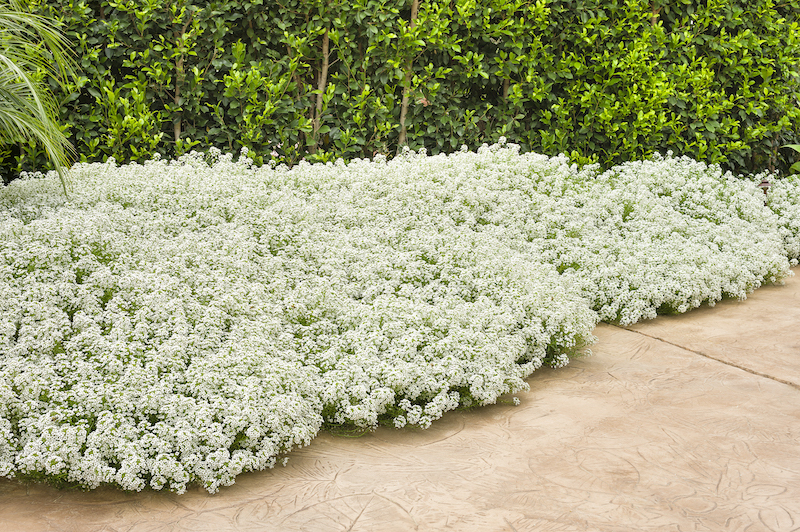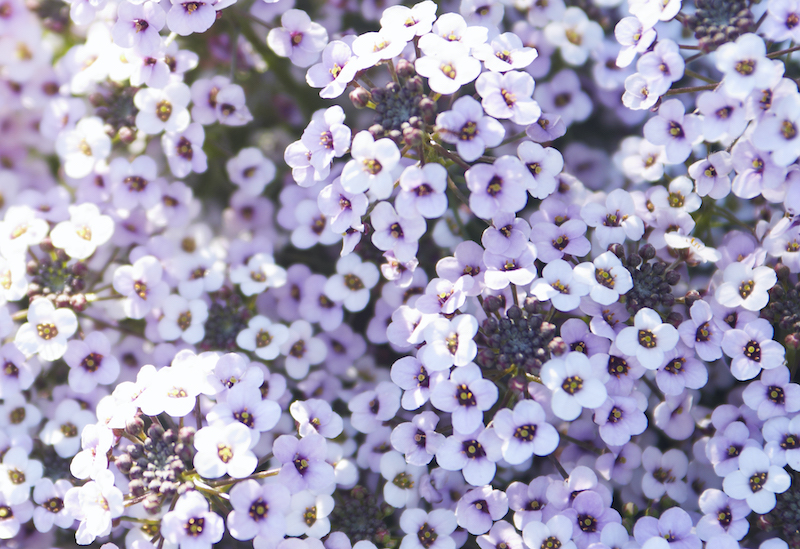Hardy annuals, like Alyssum, bloom from early spring until the first frost in fall. There may be periods when the plants slow down flowering or seem to stop growing altogether. Knowing the correct watering, pruning, and fertilizing techniques will help revive your Alyssum plants and continue their bloom display.

Common Reasons Why Alyssum Isn’t Blooming
There are typically four reasons why Alyssum is not blooming well.
1. Over- or underwatering. Both drought and boggy conditions will stress Alyssum so that it stops blooming and will put all of its energy into preserving the root system. Alyssum likes to dry out a bit in between waterings.
2. Lack of sufficient sun exposure. Alyssum needs at least 6 hours a day of full sun to continue to set flower buds and for the soil to dry out in between waterings.
3. Inconsistent fertilizing or using the wrong fertilizer. Use a formulation with a ratio of N-P-K approaching 1-4-3 or 0-10-10. Higher Phosphorous numbers ensure that the plant will not be forming too much foliage. Continue feeding Alyssum throughout the growing season.
4. Hot temperatures. Alyssum prefers the cooler temperatures of spring and fall. At the height of summer, it will slow down growth considerably and need a brief rest before continuing growth as the temperatures cool in late summer.

Pruning Alyssum To Help It Bloom
Alyssum will benefit from shearing back once the weather heats up in summer. As the growth slows and becomes leggy, cut back the top growth by half. This gives the plant a chance to rest and recover from the first bloom cycle. Continue watering regularly and fertilize the plant. Growth should resume in 2-3 weeks.
The same shearing can be done for perennial-grown Alyssum. In the fall, as the weather cools, cut back the top growth by half and fertilize plants. This seasonal pruning helps the plants recover from a hot summer and prepare for vigorous growth through the winter.
Fertilizing Alyssum To Help It Bloom
Fertilizing with the proper formulation is essential. A fertilizer that has too much Nitrogen will result in plants that produce more foliage than they need and too few flowers. Excess foliage may also be weak and susceptible to attacks from pests and disease. Feed Alyssum with high-Phosphorus fertilizers, which support flowering.
Diluted liquid fertilizers deliver the quickest feeding. Slow-release formulas provide a low level of nutrients over a longer period. Regular mulching of perennial-grown Alyssum with organic compost will slowly feed the soil and improve the soil texture over time.
Get Alyssum To Produce More Blooms
Deadheading of the spent blooms, instead of shearing back the whole plant, will help to produce more flowers during the bloom cycle. Trimming bloom stems with a pair of sharp snips or scissors will also tidy up the plants, helping Alyssum retain its mounding or trailing shape.
Why Alyssum Isn’t Blooming
- The wrong type of fertilizer
- Not enough sun exposure
- The weather is too hot
- Overwatering or underwatering
 |
Author Robbin Small - Published 12-16-2022 |
